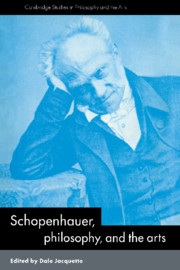Book contents
- Frontmatter
- Contents
- List of contributors
- Editor's acknowledgments
- List of abbreviations
- 1 Schopenhauer's metaphysics of appearance and Will in the philosophy of art
- PART I The work of art: Schopenhauer on the nature of artistic creation
- PART II The experience of beauty: Schopenhauer's theory of aesthetic encounter
- PART III Schopenhauer's enduring influence on the arts: idealism and romanticism
- 9 Schopenhauer on music as the embodiment of Will
- 10 Schopenhauer and the musicians: an inquiry into the sounds of silence and the limits of philosophizing about music
- 11 Metaphysics and aesthetics: a case study of Schopenhauer and Thomas Hardy
- 12 Schopenhauer according to the Symbolists: the philosophical roots of late nineteenth-century French aesthetic theory
- 13 Schopenhauer's philosophy of architecture
- Bibliography of selected sources on Schopenhauer's aesthetics
- Index
13 - Schopenhauer's philosophy of architecture
Published online by Cambridge University Press: 05 May 2010
- Frontmatter
- Contents
- List of contributors
- Editor's acknowledgments
- List of abbreviations
- 1 Schopenhauer's metaphysics of appearance and Will in the philosophy of art
- PART I The work of art: Schopenhauer on the nature of artistic creation
- PART II The experience of beauty: Schopenhauer's theory of aesthetic encounter
- PART III Schopenhauer's enduring influence on the arts: idealism and romanticism
- 9 Schopenhauer on music as the embodiment of Will
- 10 Schopenhauer and the musicians: an inquiry into the sounds of silence and the limits of philosophizing about music
- 11 Metaphysics and aesthetics: a case study of Schopenhauer and Thomas Hardy
- 12 Schopenhauer according to the Symbolists: the philosophical roots of late nineteenth-century French aesthetic theory
- 13 Schopenhauer's philosophy of architecture
- Bibliography of selected sources on Schopenhauer's aesthetics
- Index
Summary
AGAINST THE CLASSICIST PARADIGM
Schopenhauer's The World as Will and Representation marks the boundary between the classical and modern paradigms of architectural knowledge. Since the Italian Renaissance, the reciprocity between structure, function, and art in architecture had always been problematic. Yet, up until the eighteenth century, architectural theorists broadly agreed on Vitruvius' dictum that architecture “must be built with due reference to durability, convenience, and beauty.” With classical treatises, the Vitruvian trinity portrayed architecture as an objective system. The most important element of this doctrine was the belief that all architectural forms and relations were rooted in the imitation of nature.
Economic and intellectual upheavals during the eighteenth century recast the foundations of architectural knowledge from objective nature to the subjective mind. Individual drives and behavior were increasingly studied as the key to understanding architectural form. The Vitruvian trinity, however, did not work as well as a mirror of the human mind as it did of nature. By Schopenhauer's time, in the wake of new discourses on utility and pleasure, rule and imagination, and cognition and perception, the Vitruvian trinity began to seem outdated. The modern aesthetic brought down architecture's classical edifice. In particular, Schopenhauer's aesthetic annexed architecture to the subjective Will and in turn redefined the classical notions of function, beauty, and structure.
Working from the non-instrumental framework developed within late eighteenth-century German philosophy, Schopenhauer denied artistic meaning to architecture's functional role.
- Type
- Chapter
- Information
- Schopenhauer, Philosophy and the Arts , pp. 277 - 298Publisher: Cambridge University PressPrint publication year: 1996
- 1
- Cited by



